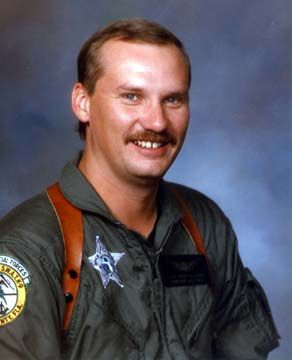 Dave Oglesbee was born August 15,1962, in Camanche, Iowa. His dad noted his interest in RC airplanes, gave him achance at the real thing, and Dave was hooked. He worked at the airport for payfor flying lessons and missed his high school senior group picture to take hisprivate checkride. He earned an ROTC scholarship to the University of Dubuque,graduated Magna Cum Laude in 1984, and joined the Army. He flew helicopters atFt. Rucker, Ala., Ft. Stewart, Ga.., and Ft. Irwin, Calif.
Dave Oglesbee was born August 15,1962, in Camanche, Iowa. His dad noted his interest in RC airplanes, gave him achance at the real thing, and Dave was hooked. He worked at the airport for payfor flying lessons and missed his high school senior group picture to take hisprivate checkride. He earned an ROTC scholarship to the University of Dubuque,graduated Magna Cum Laude in 1984, and joined the Army. He flew helicopters atFt. Rucker, Ala., Ft. Stewart, Ga.., and Ft. Irwin, Calif.
In 1990, just before Desert Storm, he resigned his commission and flew forthe Sheriff’s Department of Marion County, Fla. He transported prisoners inrented airplanes, and flew patrols in the department’s new MD500. He chased bothgood guys — flying lots of search and rescue of Florida’s elderly population —and bad guys — he won a FLIR award in 1995after finding and tracking a fleeing suspect. In 1995 he became Chief Pilot forthe Florida Fish and Wildlife Agency, supporting the conservation effort,including supervising the legal collection of alligator eggs from the air, andchasing the poachers. He recently left that post to help develop the motivationand recognition of airborne law enforcement associations around the country.
How did you get interested in aviation? Were there pilots in your family?
I didn’t have anyone in my family who had ever been a pilot. As a matter offact, I don’t believe that anyone in my family had ever flown in an airplaneother than a commercial airline.
My dad worked for an oil pipeline company. They had a contract pilot thatflew the pipeline in a Cessna 172. I would ride with him from Colorado where Ilived with my parents, to Kansas where my grandparents lived. This was myintroduction to flying and came to me when I was about eight years old.
I really got into flying when I was in high school growing up in Camanche,Iowa. I had a cousin who was into remote-controlled airplanes. I had watched himbuilding them and talked about flying them with him and I wanted one in theworst way. I asked my parents for one for my 17th birthday, just before mysenior year. My father said he would look into it but he didn’t think it wasworth the money. I was shocked when he came to me a couple of days before mybirthday and told me I could either have the remote-controlled airplane or aflying course he had found called the "Blue Sky Course." He explainedthat for the same amount of money as the remote-controlled airplane, he couldbuy this course which would give me 13 hours of flight instruction, including asolo flight in a real airplane. After about 1/10 of a second of thought, Idecided that actual flying had to be better than the remote-controlled stuff. Ididn’t know that my father had failed to discuss this with my mother. It didn’ttake much to talk her into it.
On my 17th birthday, he took me to the airport and I took my introductoryflight in a Piper Cherokee 140. I was hooked after that.
The 13 hours of flight soon ran out. I was well into soloing by now andreally enjoyed it. I didn’t have any money to pay for the rest of the training.I went to the owner of the FBO, Mr. Straley of Straley Aviation in Clinton,Iowa. I explained to him my extreme desire to fly and my need for a job, and hehired me and took me under his wing. Under the agreement, I worked, the moneywent on account, I flew as much as I needed to and neither one of us worriedabout whether he owed me or I owed him. I think we came out pretty even.
I could never thank him enough.
Who got the first ride, your dad or Mr. Strayley?
My first ride after I got my license was with my dad. He had a great time. Iflew often with Mr. Straley and he told me he really loved the way I flew andwould fly with me any time. Again, small words that I’m sure he quickly forgotbut I never will.
I gave my grandfather his first small aircraft ride. He was in his late 60sat the time. That was a thrill. This happened about three weeks after I got myrating.
Who gave you the checkride?
I took my check ride with a guy named Fred DeKyrl, and I missed my seniorgroup picture in order to take it. Fred was in the Army Air Corps at theoutbreak of WWII. He never entered the war because he was to old. He was aninstructor in the states instead. That should give you an idea how old he was in1980.
How did you get into the Army?
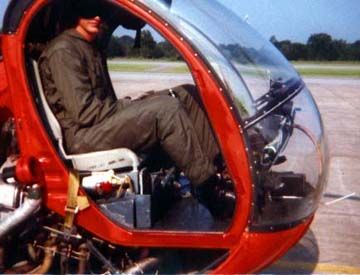 | |
| Close quarters in a TH-55 at Ft. Rucker, Ala. (1984). |
I went straight from high school to the University of Dubuque in Dubuque, Iowa.They had an aviation program — a part 141 school — as part of their academicprogram. After my freshman year, even though I was on a partial academicscholarship, I couldn’t afford to keep the flying part up. The Army ROTCdepartment got my name from somewhere, and after I talked to them I decided totake the test for a scholarship, and I was lucky enough to pass.
The Army ROTC scholarship was great at the time. They paid for all of myflying, books, tuition and fees. The college still gave me my academicscholarship so I was actually paid to go to college — pretty good deal. I waslucky enough to be one of fifty ROTC cadets from across the country who wereselected to attend the cadet flight training program at Fort Rucker, Ala.,between my junior and senior year.
I graduated Magna Cum Laude in 1984 with a degree in aviation flightoperations and one in aviation management. The same day I graduated I wascommissioned a Regular Army Second Lieutenant and left for Officer Basic Coursein Ft. Bliss, Texas. Army aviation had just become a branch the year before andtheir basic course was not quite ready yet. The Army, in its infinite wisdom,sent me to the Air Defense Basic Course. It made me feel great about my careerchoice to fly through these great defenses.
How did you transition to helicopters?
I started flying helicopters at Ft. Rucker, Ala. I guess I had been in theactive duty Army for about three months at that point. Rucker was real active in1984 — helicopters in the air night and day.
I graduated flight school in May of 1985. For six months I waited at Ruckerfor the Black Hawk transition which I was supposed to receive. The problem wasthat the Black Hawks were grounded because they were coming apart in flight andthey didn’t know why. I was finally sent to Ft. Stewart, Ga. — Hunter ArmyAirfield — flying Hueys. Unfortunately they didn’t need any Huey pilots at thetime, so they transitioned me to an OH-58 pilot.
The OH-58 is one of the most basic aircraft in the Army inventory. Theaircraft we flew were the A model and the C model, and now they use the D model.The A and C models were basically the same in appearance, except the C model hadwhat they called "flat glass". The windshield was totally flat whichwas supposed to reduce the amount of glint the enemy could see as the sunreflected off of you. It also required a separate structural piece on each sideof the windscreen so that the side glass could be put in. This created atremendous obstruction to the vision of the pilot. The C model also had a biggerengine and had dual tail rotor controls. They were both basically"slick" aircraft.
They were forming a new attack battalion, and I got a platoon leader’s jobflying the OH-58 as an aerial scout, which was much more fun and exciting.
What does an aerial scout do?
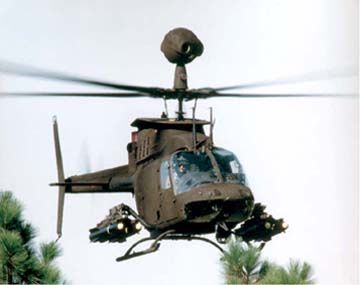 | |
| U.S. Army OH-58 in the treetops |
We did the same things you saw the scouts do in the old movies, we just did itfrom the air. A lot of low and slow flying, sneaking and peeking and being theeyes and the ears of the Division. We often flew with the aircraft itself in thetrees with just the main rotor sticking out above the trees. This was usuallydone at less than 40 KIAS.
The whole concept of tactical flying at the time was the lower you were, thebetter chance you had to survive. I do not ever remember flying tactically atover 100 feet AGL. We often trained at the NationalTraining Center in Ft. Irwin, Calif., in the high Mojave desert about 30 orso miles outside of Barstow. We would fly less than 10 feet AGL at around 100KIAS. That’s the way we were trained to fly and the only way we would survive inthe open environment of the desert. Of course there were no wire hazards andwhat hazards existed were clearly marked on our maps. It’s amazing, and I guessit could be attributed to youth, but you could get really comfortable flying inthat environment. Of course if you want to do that kind of flying, join theArmy, don’t try it in your Cessna.
These scout aircraft were totally defenseless. We carried no weapons (otherthan personal weapons) on board. The D model, which came later, did have theability to defend itself. It was good work. That was my most enjoyable job inthe Army.
What else did you fly?
The most fun aircraft I flew was the UH-60 Black Hawk. This is truly atremendous aircraft, with more power than can be imagined for a helicopter ofits time. Totally empty or fully loaded, it was amazing. It went through itsgrowing pains initially and unfortunately some good crews lost their lives butin my opinion it turned out to be one of the best helicopters the Army everpurchased.
We just lost aBlack Hawk in a night-training excercise in Hawaii. While we don’t know yetwhat caused the accident, can you give us an idea of how you train in closeformation with night-vision goggles?
Anytime you have two aircraft flying in very close proximity to each other,you increase the hazard. In Hawaii they were using night-vision goggles, but itwasn’t that long ago that two Black Hawks ran together during a daytimedemonstration. Formation flying requires the crew’s 110% attention, and when youadd the goggles they have to be that much more attentive. The aircraft wereprobably supposed to be within about a rotor disk of each other. The closer youare, the easier it is to tell if you are moving in relation to the otheraircraft. It’s like following a car, if you are only two feet behind the othercar, you can tell when you move a foot in relationship to it, if you are 100feet away, your position may have to change by 40 feet or more before yourealize it. With goggles, you definitely want to be close so you can tell if youare moving in relation to the other aircraft. You don’t want a huge closure rateto sneak up on you.
I assume there were only two aircraft involved in the formation, which makesit easier — the more aircraft you have, the more difficult it gets. When youhave numerous aircraft, a very small change by the lead aircraft can result in ahuge change by the trail aircraft — the accordion effect. These aircraft flythese type of missions safely every night. In this case, one of the crews mayhave been distracted by a caution light or another emergency. I personally hadan engine fail on a Black Hawk while flying night-vision goggles in a formation,carrying a sling load. I was chalk two in a flight of three. I can tell you yourattention can quickly be diverted and for a second or two, you forget you haveother aircraft around you. Your attention totally goes toward your aircraft andyour problem.
Vertigo is another problem crews sometime experience using goggles. Thegoggles only have a 40-degree field of view. It’s like flying looking through atoilet paper roll. You have to constantly move your head. This can lead toserious cases of vertigo. The trail crew may have experienced this or the leadcrew may have done something unexpected and the trail crew did not have time toreact to it. There are a number of optical illusions that a crew can experienceat night. It would just be impossible to try and guess what happened from theinformation I’ve seen.
I can say that the goggles are a tremendous tool. Night provides concealmentfor the combat helicopter aviators. Goggles allow night flight to be performedat the altitudes necessary better than any other technology currently availablein the field.
When did you leave the Army?
I resigned my commission on July 15, 1990 — 18 days before Desert Shield —and went to work for Marion County Sheriff’soffice in Florida. I was hired as a pilot but the sheriff sold thehelicopter before I got through the academy. I worked undercover in streetcrimes unit and then went to uniformed patrol. We didn’t do a lot of prisonertransport, and when we did we rented planes.
We flew Aileen Wournos in a Piper Archer. She was notorious at the time asthe only female serial killer in the USA. She has since been convicted ofkilling five men over a short period of time in central Florida. I believe shestill is in the appeals process but she has been sentenced to the death penaltyin Florida. All of her victims had been located except one. She was brought fromBroward County, in south Florida, to Ocala, in central Florida, to try anddescribe where the remaining victim was located. I wasn’t in on the detectivepart of this case, but she apparently thought that she would be able to find thevictim if she could just return to that area.
Myself, another deputy pilot, a female guard and Aileen Wournos met at theairport the following morning. The general feeling among the flight crew wasthat this person had absolutely no reason not interfere with the crew if she gotthe chance. Of course we wanted her cooperation so that the victim’s familycould find some closure, but we didn’t want to be stupid, so it was decided thatMs. Wournos would remain shackled during the entire flight. The flight crew wasnot in uniform but we were armed.
Everything seemed to go pretty well until our passenger decided it was timeto go to the bathroom and if we didn’t land in just a few minutes, she could nothold it. We found a strip somewhere around the Vidalia, Ga., area, as best as Ican recall. I do remember that there was only one locked building on the field.The guard and the prisoner retreated to a thicket of woods from which they bothreturned, amazingly enough.
The other victim was not located and we returned Ms. Wournos to BrowardCounty that night. We flew over Disney World just as the fireworks went off.It’s an amazing sight, even when you have a serial killer in the backseat.
Did you transport any other interesting criminals?
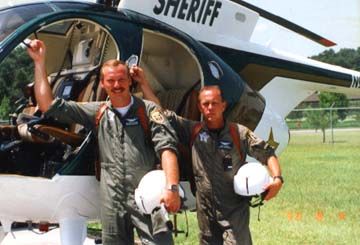 | |
| Dave and his first observer, Deputy Ed Mobley preflight a Hughes 500D, 1991 |
My phone rang about 10 o’clock one night on a rare day off and it was thesheriff — not necessarily a good sign. One of our neighboring counties had akidnapping homicide. The suspects had just been involved in a shootout inMississippi and their investigators needed to get to the suspects ASAP. Ipointed out the sheriff that we did not own any aircraft and we didn’t haveaccess to the rentals at that late hour but I would see what I could do. I had afriend at a neighboring sheriff’s office that owned a Seneca, and he agreed topick me up. The plan was to arrive at our neighboring county at about midnight,pickup the investigators and travel on to Mississippi. After a brief interviewand an opportunity given to the crew to rest, the flight proceeded back homewith one of the suspects on board. The suspect confessed and took theinvestigators to the location of the victim. I felt liked we helped the familyget some closure on this one.
The Sheriff’s office then bought a new MD500 helicopter and went to flyingfull time. I helped develop the new unit and bring it on line.
Tell us about the FLIR [Forward LookingInfraRed] award that you won.
We got the award for a chase that occurred in the spring of 1995. It startedwhen a deputy pulled up behind a car in a known drug area. The deputy approachedthe car and saw what he believed to be crack cocaine on the seat. He ordered thedriver out of the car. The driver reached for the gear selector and the deputyreached inside to stop him. Too late. The suspect dragged the deputy for about40 feet as I remember. We were in the air and the description of the car wasdistinctive — a 1991 Caprice Classic pulling a trailer with a lawn mower on it— and we found it in just a few minutes. Ground units were called in and thechase was on. He proceeded from one town to another. The county sheriff’s officeand at least two different city PDs were involved at one time or another. Wecaught it all on tape from the helicopter’s FLIR system. The chase actuallystarted during the day, but it didn’t end until it was dark.
The suspect was passing a line of traffic and the car in the front of theline was turning left in front of the suspect. They had a pretty bad collision.But our suspect was not through. He bailed out of the car, ran across a prettygood-sized field, jumped a couple of fences and hid in a thicket. We could notsee the suspect in the night sun but we could see him on the FLIR.
The first deputy to respond to the scene did not have a radio. He was lookingaround within a few feet of the suspect but he could not see him. Since he didnot have a radio, he couldn’t hear our directions to him. It makes for a cutevideo with this deputy standing within three feet of what he’s looking for andnot finding it. Another deputy did arrive with a radio and we talked him to thesuspect for the arrest.
Tell us about some of the bad guys you’ve chased.
It’s kind of funny watching a suspect run on foot when you are chasing himwith a helicopter. I’m not sure what they are thinking.
We had a carjacking take place. We were on a static display of the aircraftwhen the call came in. As soon as we got the college students back a safedistance, we cranked and left. One of the road supervisors happened to locatethe vehicle and turned on his blue lights as he rounded a corner, then suspectdecided to head on the patrol vehicle. No one was seriously hurt but the suspectdriver bailed out and ran. We arrived overhead just as the head on occurred.
The suspect began to run and started looking over his shoulder, he’d run somemore and look at the aircraft again. You could tell he was getting reallyfrustrated with all of this. He eventually dove through a row of bushes and cameout into a parking lot. He ran around the same building three times, looking atthe aircraft in disgust most of the way. Little did he know, the building he wasrunning around was the regional headquarters for one of our state lawenforcement agencies. An officer came outside to see what the helo was doing andthe suspect rounded the corner on his third trip around. The officer took quickaction and arrested the suspect.
One of the funniest suspect searches we had came as a result of a sexualbattery call if I remember correctly. We responded on a call out to the scene.It was day time and the ground units had a pretty good perimeter set up. Webegan the search while we waited for the K-9 unit to arrive. We worked welltogether. The aircraft generally made to suspect hide, the K-9 could track rightto them since they were no longer fleeing. In this case, we saw which way theK-9 was tracking and just headed off at a slow airspeed, tree top level overthis wooded area. I saw something that looked like a small piece of material inthe top of the tree. We turned around and there set our suspect, in the top of atree covered in Spanish moss. Not a bad idea but it didn’t work.
And how about the searches and rescues.
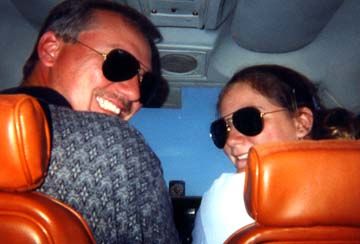 | |
| Dave passes the torch to his daughter Bethany in a C-172. Photo was taken by Dave’s son Lance, 2000 |
Florida has a large elderly population, and we worked a lot of searches formissing and overdue elderly people. Most of them had Alzheimer’s and hadwandered off. One case was of an elderly gentlemen, I believe in his 80s. He didnot have Alzheimer’s but he was missing. He had left his residence the daybefore. This also occurred in a neighboring county that did not have anaircraft. They searched for about 22 hours and could not find the victim.
It was hot, highs in the 90s, and they started to get very concerned. Ourassistance was requested. We landed at the police department headquarters andpicked up an officer who knew the area. He had some places that had beensearched by ground that they wanted to look at from the air. The second place wethe victims van was spotted. He had driven off of the road, through some treesand the van had become stuck. The victim was unable to walk so he had stayedwith the van. After we landed, we approached the van — not expecting to findthe best — but he was alive. We carried the victim from the van to thehelicopter and had him at the hospital in less than an hour from when we beganour search. Doctors said he only had a little time to live due to dehydration.He later stated that he had heard the ground search going on nearby but his horndid not work and he couldn’t call out for help. Things like that make itworthwhile.
I was hired as the Chief Pilot for the Florida Fish and Wildlife Agency in1995. They are a tremendous conservation agency. The flying with them was great.We worked the entire state of Florida, from the keys up through the Evergladesand on up into the panhandle region. Some of the most beautiful sights you couldimagine. Most of our efforts were related to conservation efforts both throughlaw enforcement efforts and through research efforts. One of the mostinteresting things you could ever witness from the air is the collection ofalligator eggs.
The state of Florida allows vendors, under the direction of Fish andWildlife, to collect alligator eggs. Those eggs are hatched and raised and thatis where the majority of your gator tail and alligator skin brief cases comefrom. Through the success of management programs, all of the gators cannot beallowed to hatch in the wild. We would fly lakes as directed by the biologistlooking for alligator nests. They are very hard to see from the surface but fromthe air they look like big mounds of mud in an otherwise vegetated area. Wewould direct these vendors in their air boat towards these nests.
This is done is late June and early July. This water obviously has a huge,probably mad, alligator in it, along with numerous water snakes. These guyswould jump out of their air boat, get on top of the nest, break it open, takethe eggs and get back in their air boat. No one has ever been seriously hurtdoing this. As the agency covering the wild areas of Florida, we also did atremendous amount of search and rescue, both over the ocean and gulf and theinland areas. I took an early retirement from Fish and Wildlife to pursue otherinterests.
What are you doing now?
I’m currently working with lots of other people to develop a some sort ofrecognition process for airborne law enforcement units. The vast majority ofairborne law enforcement units are very professional and do a tremendous job ofprotecting the public. We are trying to develop a standard by which those unitscan be recognized. The idea is to recognize those professional units whichalready exist, and those that are starting out and are headed in the rightdirection, to give them a goal to reach. It’s a long way from being completedand it is very difficult to cut a new trail but I think this is a veryworthwhile project that may save some police officer’s life some day.


































